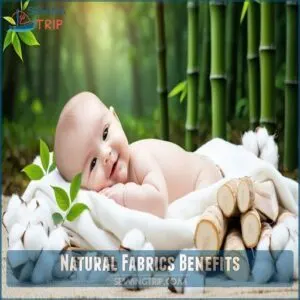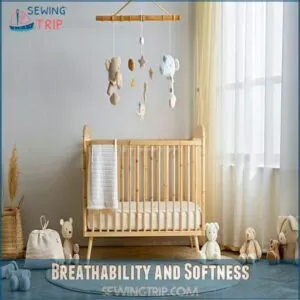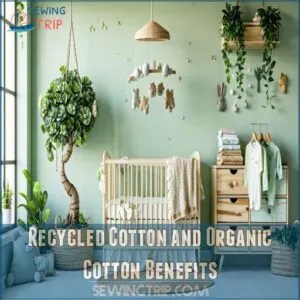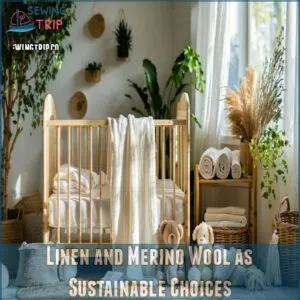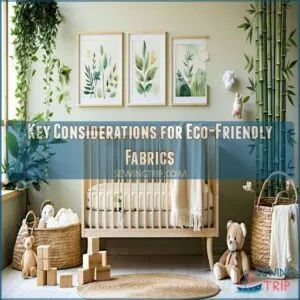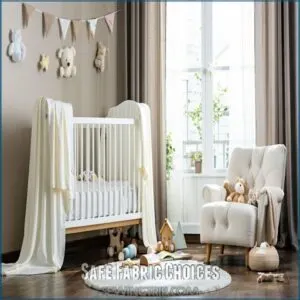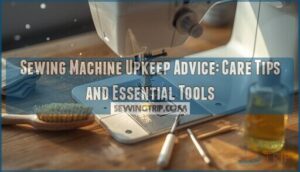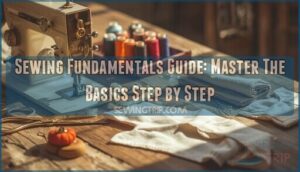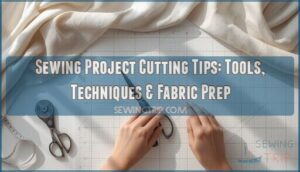This site is supported by our readers. We may earn a commission, at no cost to you, if you purchase through links.
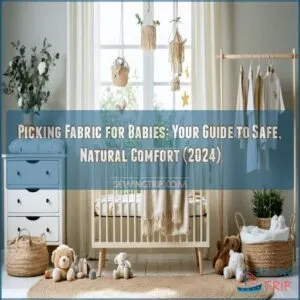 When picking fabric for babies, prioritize soft, breathable, and hypoallergenic materials like organic cotton, bamboo, or Tencel. Baby skin is 30% thinner than yours, making it more prone to irritation.
When picking fabric for babies, prioritize soft, breathable, and hypoallergenic materials like organic cotton, bamboo, or Tencel. Baby skin is 30% thinner than yours, making it more prone to irritation.
Natural fabrics create a gentle, breathable layer that prevents overheating and keeps sensitive skin happy. Look for certifications like GOTS to confirm the fabric is free from harmful chemicals.
Plus, eco-friendly fabrics like organic cotton and bamboo aren’t just good for your baby—they’re kinder to the planet too. Stick to machine-washable options for convenience because, let’s face it, spit-ups happen. Want cleaner skin and sleep? The right fabric can help.
Table Of Contents
Key Takeaways
- Choose soft, breathable, and hypoallergenic fabrics like organic cotton or bamboo to protect your baby’s sensitive skin.
- Stick to eco-friendly options like GOTS-certified fabrics to avoid harmful chemicals and dyes.
- Opt for machine-washable, durable fabrics that maintain comfort and softness for daily use.
- Prioritize moisture-wicking materials to prevent overheating and skin irritation.
Natural Fabrics Benefits
You’ll find that natural fabrics like organic cotton and bamboo create a gentle, protective layer for your baby’s sensitive skin while letting it breathe freely.
These fabrics won’t just keep your little one comfortable – they’re also better for the environment, breaking down naturally without leaving harmful residues behind.
Breathability and Hypoallergenic Properties
Two essential qualities make natural fabrics perfect for your baby’s delicate skin.
Breathable fabrics allow air circulation, preventing overheating and skin irritation that can lead to rashes.
Meanwhile, hypoallergenic materials like organic cotton and bamboo work as nature’s shield, protecting against allergic reactions without harsh chemicals.
For more information on hypoallergenic cotton, consider exploring the various types of cotton fabrics available.
Think of these fabrics as your baby’s personal climate control system, keeping them comfortable and safe around the clock.
Softness and Gentleness for Baby Skin
In the case of delicate fibers for your little one, soft baby fabrics aren’t just a luxury—they’re essential for healthy skin development.
Your baby’s skin is actually 30% thinner than yours, making gentle materials vital. Look for fabric texture that feels cloud-like against your fingers, particularly organic baby fabrics like bamboo and cotton.
These hypoallergenic options provide skin comfort while preventing irritation and rashes. Parents can explore soft fabrics to find the perfect materials for their baby’s sensitive skin.
Environmental Impact of Natural Fabrics
Looking beyond the cradle, natural fabrics leave a gentle footprint on our planet. When you choose eco-friendly materials like organic cotton and sustainable textiles, you’re helping create a cleaner world for your little one’s future. Understanding natural fibers is important in making informed decisions about the environmental impact of your choices.
- GOTS-certified fabrics guarantee green production methods while eliminating harmful chemicals.
- Biodegradable options like bamboo and hemp naturally decompose in months, not centuries.
- Natural fibers require less water and energy during manufacturing, reducing their carbon footprint.
Fabric Characteristics Matter
Choosing the right fabric for your baby’s comfort is like selecting their first tiny blanket – every detail matters.
When you’re examining textures, pay attention to absorbency and durability since these qualities directly impact your little one’s daily comfort.
Lightweight, hypoallergenic materials should top your list, as they’re gentle on sensitive skin.
You’ll want the fabric’s weight too – it shouldn’t be too heavy or restrictive. Natural fibers typically offer the best combination of softness and practicality, making them ideal for your baby’s delicate needs.
For the best comfort, look for the softest fabric options that balance breathability with durability, ensuring your baby stays comfortable throughout the day.
Breathability and Softness
You’ll want to keep your baby’s sensitive skin happy by choosing fabrics that let air flow freely and prevent moisture from getting trapped against their delicate skin.
Natural materials like cotton and bamboo don’t just feel cloud-soft against your little one’s skin – they’re also excellent at keeping your baby comfortable by allowing proper airflow throughout the day.
Importance of Air Circulation for Baby Comfort
Choosing the best fabric is important for their comfort and health. After understanding fabric types, let’s focus on why they need to breathe.
Your baby’s thermal regulation depends heavily on air circulation through their clothes. When you pick breathable fabrics, you’re helping their tiny bodies maintain the perfect temperature – not too hot, not too cold.
Think of it like a gentle breeze flowing through their clothes, keeping their sensitive skin happy and healthy all day long.
Trapped Moisture and Skin Irritation
When baby skin gets damp, it’s a recipe for rashes and discomfort. Trapped moisture can irritate their sensitive skin.
So look for breathable, moisture-wicking fabrics like cotton or bamboo. These hypoallergenic materials let air flow and keep them dry throughout the day.
Preventing rashes isn’t just about lotion—it starts with choosing fabrics that put comfort first.
Ideal Fabrics for Breathability and Softness
Finding the best baby fabrics means focusing on breathability and softness to keep your little one comfy and rash-free. Go for gentle choices with moisture-wicking and temperature-regulating qualities.
Look for these:
- Cotton: Breathable and soft for everyday comfort.
- Bamboo: Ultra-gentle and naturally anti-bacterial.
- Linen: Light, airy, and durable.
- Merino Wool: Insulates without overheating.
- Jersey Knit: Soft, stretchy, and easy-care.
Sustainable Fabric Options
Choosing sustainable fabrics like organic cotton or linen protects your baby’s sensitive skin and the planet.
These eco-friendly options are gentle, durable, and free from harmful chemicals, making them a safe and smart choice for your little one.
Recycled Cotton and Organic Cotton Benefits
Choosing sustainable fabrics like organic and recycled cotton is a win for you and the planet.
Organic cotton supports pesticide-free farming, protecting soft baby skin while conserving water. The numerous organic baby benefits make it a popular choice among parents.
Recycled cotton cuts waste, promoting a circular economy.
Both options reduce environmental impact and offer breathable, gentle fabric for baby clothes. It’s the perfect mix of comfort and eco-conscious baby fabric choices.
Linen and Merino Wool as Sustainable Choices
Linen and merino wool are game-changers for ecofriendly baby clothing.
Linen, a breathable natural fiber, softens with each wash and keeps babies cozy year-round.
Merino wool offers natural insulation, regulating temperature without overheating, and it’s great for sensitive skin.
Both sustainable materials are durable, renewable, and biodegradable, giving you “green clothing” options that protect your baby’s comfort and the planet.
When choosing the softest fabric for your baby’s clothing, consider the benefits of natural fibers like linen and merino wool.
Key Considerations for Eco-Friendly Fabrics
You’ve got a lot to think about when picking eco-friendly materials for your baby.
Look for sustainable textiles like organic cotton or bamboo, which balance baby safety and environmental impact.
Hypoallergenic fabrics keep sensitive skin happy, while breathable options like linen guarantee comfort year-round.
Trust certifications like GOTS for truly green clothing that’s as safe as it’s sustainable.
Safe Fabric Choices
You want fabrics that keep your baby safe and comfortable, free from irritating chemicals and dyes.
Choosing certified options like GOTS guarantees you’re wrapping your little one in the safest, purest materials.
Avoiding Harmful Chemicals and Dyes
Toxic dyes and chemicals have no place near your baby’s skin. Stick to safe clothing options by choosing non-toxic textiles made with chemical-free fabrics. Look for hypoallergenic, eco-friendly materials free from irritants. Considering sustainable fabric options is essential for your baby’s health.
Here’s how to avoid harmful elements:
- Avoid fabrics with synthetic dyes.
- Opt for clothing labeled OEKOTEX.
- Prefer natural, chemicalfree alternatives.
- Research brands embracing nontoxic practices.
Certifications for Fabric Safety and Sustainability
When shopping for baby clothes, reliable certifications provide a clear roadmap to safety.
GOTS and OEKOTEX safety marks verify that sustainable textiles meet strict green standards through thorough fabric testing.
These eco labels guarantee organic cotton and other materials pass over 1,000 safety checks.
Leading certifications examine everything from threads to buttons, making it simpler to choose clothes that protect your little one’s delicate skin.
Gentle Care and Maintenance for Baby Fabrics
Safe baby fabric care starts with gentle washing. Use mild detergents, skip fabric softening, and avoid bleach—it’s kinder to delicate skin.
Air-drying keeps gentle fabrics in top shape, while low-heat drying works in a pinch. However, for those who prefer baby fabric softeners, alternatives are available.
For storage, fold baby laundry neatly in breathable containers to prevent musty odors. These laundry tips protect softness and guarantee baby clothes last longer.
Frequently Asked Questions (FAQs)
How to choose baby clothes?
Did you know newborns lose heat four times faster than adults?
Go for breathable, soft fabrics like organic cotton or bamboo.
Avoid synthetics—they trap heat.
Always check for hypoallergenic labels and steer clear of harsh chemicals.
How do I choose the best fabric for my Baby?
Choose natural fabrics like organic cotton or bamboo for your baby.
They’re soft, breathable, and hypoallergenic, keeping delicate skin comfy and safe.
Skip synthetics—they trap heat and irritate.
Your baby deserves that gentle hug of nature!
Which fabric is best for baby clothes?
Wrapping your baby in natural fabrics like organic cotton, bamboo, or linen is like giving them a soft, breathable hug.
These are hypoallergenic, eco-friendly, and perfect for keeping delicate skin comfy and safe.
Is cotton a suitable fabric for baby clothes?
Cotton’s a winner for baby clothes! It’s soft, breathable, and gentle on delicate skin.
Plus, it’s easy to care for and keeps your baby comfy in any season—cool in summer, warm in winter.
Which fabric is best for babies with sensitive skin?
Soft, soothing, and safe—organic cotton and bamboo are your go-to fabrics for sensitive skin.
They’re breathable, hypoallergenic, and super gentle.
Babies stay comfy without irritation, and you’ll love their natural, chemical-free goodness!
Is wool suitable for babies?
Wool, especially merino wool, is great for babies.
It’s breathable, regulates body temperature, and feels ultra-soft.
Look for hypoallergenic, non-itchy options labeled "baby-safe" to guarantee maximum comfort and avoid irritating sensitive skin.
What fabrics are safe for babies?
You want the safest fabrics for your baby, like organic cotton, bamboo, and linen.
They’re hypoallergenic, breathable, and soft on delicate skin.
Avoid synthetics—they trap heat and may irritate.
Let comfort guide your choice!
What is the best fabric to cloth babies in?
Soft, breathable fabrics like organic cotton, bamboo, or linen are best for babies.
They’re hypoallergenic, gentle on sensitive skin, and keep your little one comfy.
Plus, they’re eco-friendly—a win for you and the planet!
Should I buy 0000 or 000?
Go with 0000 for newborns under 8 pounds, and 000 if your baby’s a bit bigger.
Babies grow fast, so mix in both sizes to cover those growth spurts without leaving clothes unused.
Is modal fabric safe for babies?
Modal fabric is safe for babies if it’s blended with natural fibers like cotton and free of harsh dyes.
It’s super soft and breathable, but double-check care labels since improper treatment could irritate sensitive skin.
Conclusion
Let’s be honest—babies don’t exactly submit requests for soft, breathable fabrics, but their delicate skin demands it.
Choosing natural, hypoallergenic materials like organic cotton or bamboo guarantees comfort while avoiding irritation.
Sticking to fabrics free of harmful chemicals and dyes is a must, and certifications like GOTS make it easier to pick wisely.
Plus, eco-friendly options are a win for the planet too.
When picking fabric for babies, think soft, safe, sustainable—and machine washable, always.
- https://knowingfabric.com/choosing-the-right-fabrics-for-babies/
- https://lilbossaustralia.com.au/blogs/everything-baby/the-best-fabrics-for-baby-clothes-what-to-look-for-and-what-to-avoid
- https://bebencaorganics.com/en-ca/blogs/latest/choosing-the-best-fabrics-for-your-baby
- https://elieli.store/blogs/news/breathable-and-gentle-fabrics-finding-the-right-fabric-for-your-babys-clothes
- https://1000kingdoms.com/blogs/news/hypoallergenic-fabrics

